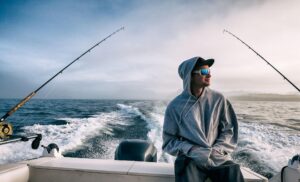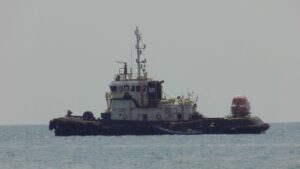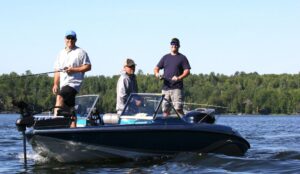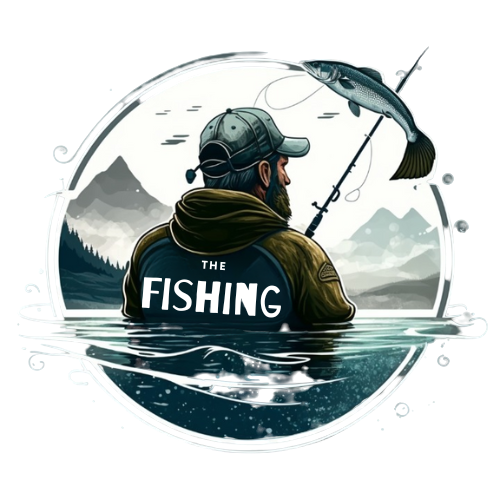If you’re an avid angler or a professional fisherman, you know that having the ability to travel long distances can be the difference between a successful trip and a disappointing one. But how far can a fishing boat travel?
In this article, we’ll explore the factors that affect a fishing boat’s range, discuss ways to optimize fuel consumption and efficiency, and provide tips for preparing your boat for a long trip. We’ll also share insights on the different types of fishing boats that are suitable for long-range trips, popular fishing destinations, and routes.
Whether you’re planning a weekend getaway or a multi-day fishing expedition, this article will provide you with the expert insights and advice you need to make the most of your trip.

Table of Contents
- How far can a fishing boat travel!
- Factors Affecting Fishing Boat Range
- Fishing Boat Fuel Consumption
- Types of Fishing Boats for Long-Range Trips
- Preparing Your Fishing Boat for a Long Trip
- Planning Your Fishing Trip: Routes and Destinations
- Optimizing Fishing Boat Speed and Efficiency
- Maintaining Optimal Performance During the Trip
- FAQs:
How far can a fishing boat travel!
Smaller fishing boats, such as those used for recreational or inshore fishing, typically have limited fuel capacity and are designed for shorter trips within a few miles of the shore.
Larger commercial fishing vessels, on the other hand, are built for longer trips and can travel much farther. These boats are equipped with larger fuel tanks, onboard facilities for crew members, and storage for supplies. Some commercial fishing boats, like trawlers or longliners, can venture hundreds or even thousands of miles from their home ports.
You may also like:
- What Should You Do If You Encounter A Fishing Boat While Out In Your Vessel Make A Large Wake Nearby?
- What Should You Do If You Encounter A Fishing Boat While Out In Your Vessel?
- How Should You Pass A Fishing Boat?
- Why should boaters slow down while passing recreational fishing boats
Factors Affecting Fishing Boat Range
There are several factors that can impact a fishing boat’s range and endurance, making it essential for fishermen to understand their boat’s capabilities before embarking on a long trip.
| Factor | Description |
|---|---|
| Fuel efficiency | The rate at which a boat consumes fuel can significantly affect its range. Boats with high fuel efficiency can travel longer distances on one tank of fuel compared to those with low fuel efficiency. |
| Engine power | A boat’s engine power determines how quickly it can move through the water, which can impact fuel consumption and endurance. Boats with more powerful engines can travel faster but may consume more fuel. |
| Boat weight | The weight of a boat, including its passengers, equipment, and cargo, can also affect its endurance. Heavier boats require more fuel to move through the water and may have a shorter range compared to lighter boats. |
| Cargo capacity | A fishing boat’s cargo capacity can impact its range, as carrying a heavy load can decrease fuel efficiency and make it more challenging to move through the water. |
| Weather conditions | Conditions such as wind, waves, and currents can impact a boat’s fuel consumption and endurance. Strong headwinds or rough seas can make it more difficult and less fuel-efficient to travel long distances. |
To maximize a fishing boat’s range and endurance, it’s important to consider these factors and adjust your trip accordingly. This may involve carrying less cargo, using a more fuel-efficient engine, or planning your trip around favorable weather conditions.
Fishing Boat Fuel Consumption
Understanding how different types of fuel affect your boat’s range and overall performance is essential. In this section, we’ll cover the basics of fishing boat fuel consumption and provide tips for optimizing fuel efficiency during your next fishing trip.
The Different Types of Fuel for Fishing Boats
Most fishing boats run on gasoline or diesel fuel. The type of fuel you choose will impact your boat’s range and overall performance. Gasoline is more common for smaller boats, while diesel fuel is typically used for larger vessels.
Gasoline is less expensive than diesel fuel, but it is also less efficient. It tends to burn faster, which means you will have to refuel more frequently. Diesel fuel, on the other hand, is more efficient and provides better range. However, it is also more expensive and may require additional maintenance.
Tips for Optimizing Fuel Efficiency
To maximize your fishing boat’s range, it’s important to minimize fuel consumption. Here are some tips for optimizing fuel efficiency during your next fishing trip:
- Travel at a moderate speed: High speeds burn more fuel, so try to maintain a moderate speed while you’re on the water.
- Reduce weight: The more weight your boat carries, the more fuel it will consume. Remove any unnecessary items to reduce your boat’s weight and improve fuel efficiency.
- Maintain your engine: Regular engine maintenance can improve fuel efficiency and reduce the risk of breakdowns or malfunctions.
- Use the right propeller: Having the right size and pitch of propeller on your boat can improve fuel efficiency by reducing drag and allowing the engine to run at optimal RPMs.
- Monitor your fuel consumption: Keep an eye on your fuel levels and consumption during your trip. This will help you adjust your speed and fuel use to maximize your range and avoid running out of fuel.
Types of Fishing Boats for Long-Range Trips

When it comes to long-range fishing trips, not all boats are created equal. Some are better suited for extended trips than others. Here are some of the most popular types of fishing boats that are ideal for long-range trips:
| Boat Type | Features |
|---|---|
| Trawlers | Large fuel capacity, spacious living quarters, and built for long-term travel. |
| Express Cruisers | Faster than trawlers, with a more sporty design and lower fuel capacity. Perfect for shorter long-distance trips. |
| Convertible Sportfishermen | Designed for both fishing and cruising, with a large fuel capacity, and amenities like a kitchen, sleeping quarters, and bathroom facilities. |
When considering a boat for a long-range fishing trip, factors like fuel capacity, size, and onboard amenities should be taken into account. The boat’s range and travel capabilities should also be considered, along with the specific fishing conditions and locations that will be encountered on the trip.
Customizing Your Fishing Boat
If you have a boat that is not specifically designed for long-range trips, there are customization options available that can help improve its range and travel capabilities. Some popular customizations include adding extra fuel tanks, upgrading the engine, and installing an autopilot system for easier navigation.
It’s important to consult with an experienced boat mechanic or builder before making any significant customizations to ensure that they are safe and effective.
Preparing Your Fishing Boat for a Long Trip
Going on a long-range fishing trip is an exciting adventure, but it’s important to ensure that your fishing boat is prepared for the journey. Here are some expert tips for getting your boat ready:
- Perform routine maintenance: Before embarking on a long trip, it’s crucial to perform routine maintenance tasks such as checking the engine oil, filters, and impellers, as well as inspecting electrical systems and fuel lines. If you’re not confident in your ability to perform these tasks yourself, hire a professional to do it for you.
- Check for leaks: Inspect your boat thoroughly for any leaks. Check the hull, the through-hull fittings, and the bilge pump to make sure that everything is watertight.
- Stock up on supplies: Make sure that you have all the necessary supplies on board, including life jackets, first aid kit, marine flare kit, and a VHF radio. It’s also a good idea to pack plenty of food and water, as well as extra fuel.
- Clean your boat: Give your boat a thorough cleaning before setting out. This will help reduce drag and increase fuel efficiency.
- Check the weather: It’s important to check the weather forecast before setting out on a long trip, and to keep an eye on the weather during the trip. If the conditions become unsafe, it’s best to return to shore.
- Practice safety: Make sure that everyone on board knows the proper safety procedures and that all safety equipment is accessible and in good working order.
By following these expert tips, you can ensure that your fishing boat is prepared for a long-range trip and that you can enjoy a safe and enjoyable adventure.
Planning Your Fishing Trip: Routes and Destinations

Planning a successful fishing trip involves more than just preparing your fishing boat and gear. Choosing the right route and destination can make all the difference in the world.
Timing Is Everything
The time of year you plan to go on your fishing trip can greatly affect your experience. Different species of fish are more active at certain times of the year. Some fish like warm water and are more active during the summer, while others prefer cooler water and are more active in the spring and fall.
In addition to considering the species of fish you want to catch, you should also consider the weather conditions. Stormy weather can make fishing difficult and even dangerous, while calm weather can enhance the experience.
Choosing the Right Destination
Once you have an idea of the time of year you want to go on your fishing trip, it’s time to choose a destination. There are countless fishing destinations around the world, each with its own unique offerings.
| Destination | Features |
|---|---|
| Alaska | Large variety of fish species, including salmon and halibut |
| Florida Keys | Warm weather year-round, lots of game fish like sailfish and marlin |
| Costa Rica | Billfish, tuna, and mahi-mahi are all abundant |
When choosing a destination, consider factors like the type of fish you want to catch, the availability of amenities like lodging and restaurants, and the overall cost of the trip.
Navigating Unfamiliar Waters
Once you have chosen a destination, it’s important to familiarize yourself with the area’s waterways. Obtain maps of the area and study them thoroughly. Pay close attention to navigational hazards like shallow water and reefs.
You may also want to consider hiring a local guide who knows the area well and can help you find the best fishing spots.
With careful planning and preparation, your fishing trip can be a huge success. By choosing the right time of year, destination, and route, you can increase your chances of catching the fish of a lifetime.
Optimizing Fishing Boat Speed and Efficiency
When embarking on a long-range fishing trip, optimizing your boat’s speed and efficiency can be the key to a successful journey. Here are some strategies to help you get the most out of your boat:
Choose the Right Propeller
The propeller on your boat plays a critical role in determining speed and efficiency. Make sure you choose the right size and pitch for your boat and engine to maximize performance. Consult your boat’s manual or a professional for guidance on selecting the most appropriate propeller.
Reduce Drag
Reducing drag is another effective strategy for optimizing speed and efficiency. This can be achieved by keeping the hull and bottom of your boat clean and smooth, ensuring that there are no obstructions such as barnacles or weeds. Additionally, removing any unnecessary weight from the boat can also help reduce drag.
Maintain Proper Trim
The trim angle of your boat can also impact speed and efficiency. Maintaining a proper trim angle can help minimize drag and improve overall performance. Make adjustments as needed depending on the conditions and speed you are traveling.
Maximize Fuel Economy
Maximizing fuel economy is critical for long-range trips. Some strategies for achieving this include reducing your speed, using your boat’s trim tabs to maintain an optimal trim angle, and avoiding rough or choppy waters that can increase drag and fuel consumption.
By implementing these strategies, you can optimize your boat’s speed and efficiency and enjoy a successful and memorable fishing trip.
Maintaining Optimal Performance During the Trip
Even with proper preparation, unexpected issues can arise during a long-range fishing trip. Maintaining the optimal performance of your fishing boat during the journey is critical to ensuring a safe and successful trip. Here are some expert tips to help you maintain your boat’s performance while on the water.
Monitor Fuel Levels
It’s essential to keep a close eye on your fuel levels to ensure you have enough to complete your journey. If possible, bring extra fuel to avoid running out in remote areas. Additionally, be mindful of how quickly you are consuming fuel and adjust your speed accordingly to conserve fuel and extend your range.
Keep the Boat Clean
Maintaining a clean boat is crucial to ensuring optimal performance. A dirty boat can create drag and reduce speed, increasing fuel consumption and reducing the distance your boat can travel. Regularly clean the hull and propeller to minimize drag and improve efficiency.
Perform Routine Maintenance
Regular maintenance checks are essential to keeping your boat in top condition during a long-range trip. Check the engine oil and coolant levels regularly and change them as needed. Inspect the fuel system and filters, and replace them if necessary. Keep an eye on the electrical system and wiring, and address any issues immediately.
Be Prepared for Emergencies
Despite your best efforts, emergencies can still happen. It’s crucial to be prepared for any scenario by carrying a well-stocked first aid kit, flares, a VHF radio, and other safety equipment. Before setting off on your trip, familiarize yourself with the location of nearby marinas and emergency services.
Following these tips can help you maintain the optimal performance of your fishing boat during a long-range trip. By staying vigilant and prepared, you can ensure a safe and enjoyable journey.
FAQs:
Q: How far can a fishing boat go on a single tank of fuel?
The distance that a fishing boat can travel on a single tank of fuel varies depending on factors such as the type of boat, engine size, and weather conditions. However, on average, most fishing boats can travel between 100 and 200 nautical miles on a single tank of fuel.
Q: What is the maximum distance that a fishing boat can travel?
The maximum distance that a fishing boat can travel depends on several factors such as the type of boat, fuel efficiency, and weather conditions. However, many modern fishing boats are designed to travel long distances, with some capable of traveling thousands of nautical miles.
Q: How do different types of boats compare in terms of range and travel capabilities?
There are several types of fishing boats, each with its own range and travel capabilities. Generally, larger boats with larger fuel tanks have a longer range and travel capabilities than smaller boats. However, smaller boats may be more fuel-efficient and able to navigate shallow waters and narrower channels better than larger boats.
Q: How can I maximize my fishing boat’s fuel efficiency during a long-range trip?
There are several ways to maximize your fishing boat’s fuel efficiency during a long-range trip, such as reducing your speed, avoiding unnecessary idling, keeping the boat properly trimmed, and reducing weight. Additionally, regular engine maintenance and using the right type of fuel can also help improve fuel efficiency.
Q: What should I include in my fishing boat’s first aid kit?
A fishing boat’s first aid kit should include basic first aid supplies such as bandages, gauze, antiseptic solution, and pain relievers. Other items that may be useful include sunscreen, insect repellent, and motion sickness medication. It’s also a good idea to include a first aid manual and emergency contact information.
Q: How can I troubleshoot common problems with my fishing boat during a long-range trip?
Common problems that can arise during a long-range fishing trip include engine failure, electrical problems, and steering issues. To troubleshoot these problems, it’s important to have a basic understanding of your boat’s systems and to carry essential tools and spare parts. Additionally, it’s a good idea to have a VHF radio and know how to use it to call for assistance if necessary.
